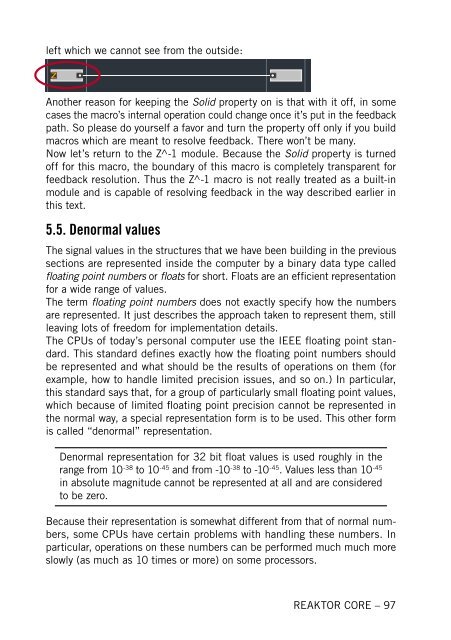1. First steps in Reaktor Core - Native Instruments
1. First steps in Reaktor Core - Native Instruments
1. First steps in Reaktor Core - Native Instruments
You also want an ePaper? Increase the reach of your titles
YUMPU automatically turns print PDFs into web optimized ePapers that Google loves.
left which we cannot see from the outside:<br />
Another reason for keep<strong>in</strong>g the Solid property on is that with it off, <strong>in</strong> some<br />
cases the macro’s <strong>in</strong>ternal operation could change once it’s put <strong>in</strong> the feedback<br />
path. So please do yourself a favor and turn the property off only if you build<br />
macros which are meant to resolve feedback. There won’t be many.<br />
Now let’s return to the Z^-1 module. Because the Solid property is turned<br />
off for this macro, the boundary of this macro is completely transparent for<br />
feedback resolution. Thus the Z^-1 macro is not really treated as a built-<strong>in</strong><br />
module and is capable of resolv<strong>in</strong>g feedback <strong>in</strong> the way described earlier <strong>in</strong><br />
this text.<br />
5.5. Denormal values<br />
The signal values <strong>in</strong> the structures that we have been build<strong>in</strong>g <strong>in</strong> the previous<br />
sections are represented <strong>in</strong>side the computer by a b<strong>in</strong>ary data type called<br />
float<strong>in</strong>g po<strong>in</strong>t numbers or floats for short. Floats are an efficient representation<br />
for a wide range of values.<br />
The term float<strong>in</strong>g po<strong>in</strong>t numbers does not exactly specify how the numbers<br />
are represented. It just describes the approach taken to represent them, still<br />
leav<strong>in</strong>g lots of freedom for implementation details.<br />
The CPUs of today’s personal computer use the IEEE float<strong>in</strong>g po<strong>in</strong>t standard.<br />
This standard def<strong>in</strong>es exactly how the float<strong>in</strong>g po<strong>in</strong>t numbers should<br />
be represented and what should be the results of operations on them (for<br />
example, how to handle limited precision issues, and so on.) In particular,<br />
this standard says that, for a group of particularly small float<strong>in</strong>g po<strong>in</strong>t values,<br />
which because of limited float<strong>in</strong>g po<strong>in</strong>t precision cannot be represented <strong>in</strong><br />
the normal way, a special representation form is to be used. This other form<br />
is called “denormal” representation.<br />
Denormal representation for 32 bit float values is used roughly <strong>in</strong> the<br />
range from 10 -38 to 10 -45 and from -10 -38 to -10 -45 . Values less than 10 -45<br />
<strong>in</strong> absolute magnitude cannot be represented at all and are considered<br />
to be zero.<br />
Because their representation is somewhat different from that of normal numbers,<br />
some CPUs have certa<strong>in</strong> problems with handl<strong>in</strong>g these numbers. In<br />
particular, operations on these numbers can be performed much much more<br />
slowly (as much as 10 times or more) on some processors.<br />
REAKTOR CORE – 97










